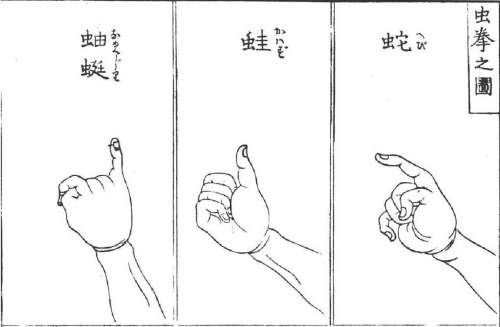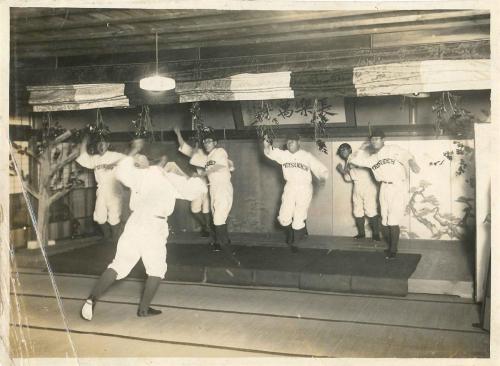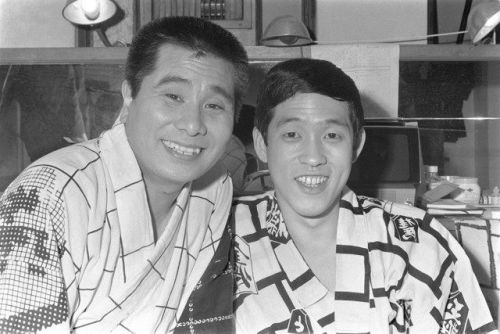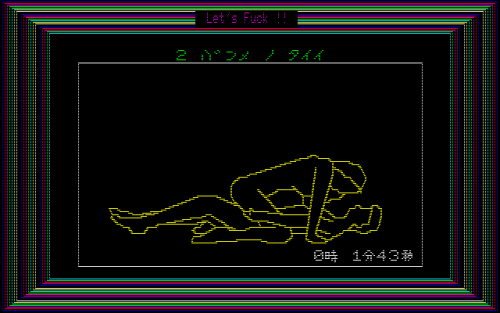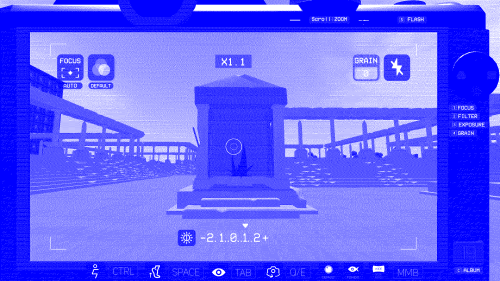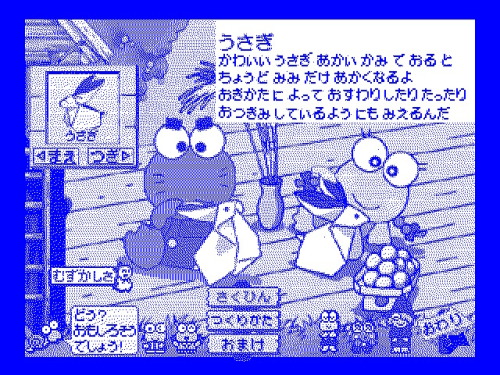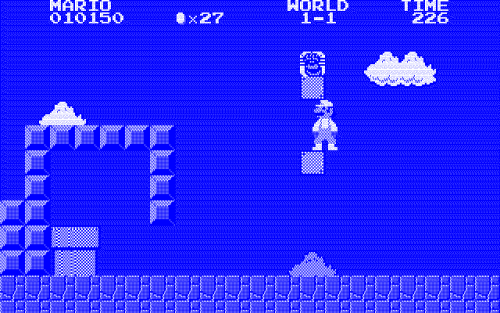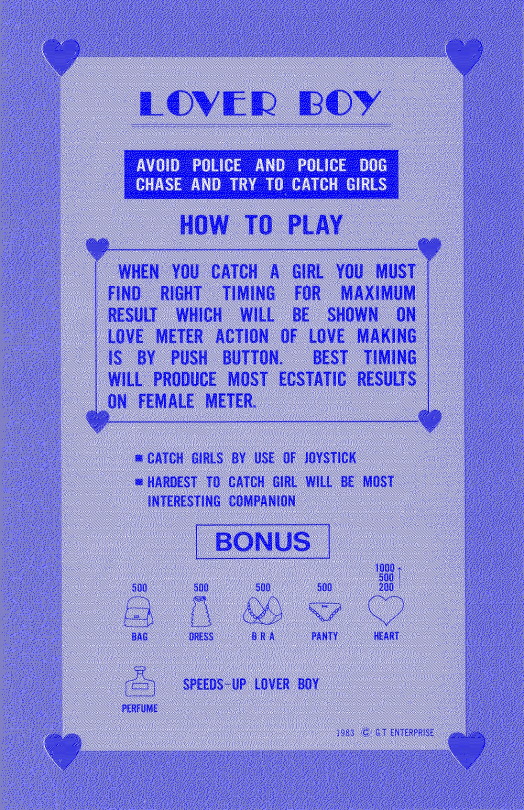
One year ago, after weeks of intensive research, I put together a culmination of available knowledge on dB-Soft’s notorious, under-documented 177. My intent was for this to be the first of many projects detailing the cultural role and history of key eroge works. My research into 177 bore fruit for seemingly countless historical forays into the likes of Lover Boy, Lolita Syndrome, Night Life, and Emmy. Information on these titles was somewhat scant to be sure, but there was enough to construct a narrative. Lover Boy was knocked out in a couple days, and in revisiting my list of potential topics I was intrigued by a title I’d popped on there without much thought:
Yakyūken (Hudson Soft, n.d.)
Supposedly this predated Koei’s Night Life and even On-Line Systems’ Softporn Adventure by quite some margin, though the specific date was up for debate if not entirely lost. If I were to talk about PSK’s Lolita: Yakyūken at some point, surely it would make more sense to tackle its progenitor first. This presented a few problems. First, there is not exactly a plethora of information about this primitive eroge. Second, it seems to have left no impact. Third, there was no way to play it. For all I knew, Yakyūken did not even exist in the first place, and if it had, nobody had bothered to back it up. VGDensetsu had collated some basic information and screenshots,[1] and BEEP had acquired a copy in 2015,[2] but these only served to tease me, increasing my appetite for forbidden fruit. The type-in version printed in MZ-700 Joyful Pack only had one page of the code documented online, and a search of previous Yahoo! Auctions listings for either cassette came up empty. But MZ-700 Joyful Pack seemed to turn up frequently, that seemed the best course of action.
Unwilling to wait for it to be listed on Yahoo! Auctions again, I turned to Kosho, Japan’s secondhand bookstore search engine. Finding one listing, without a picture, I took a gamble on a copy of what appeared to be the right issue of MZ-700 Joyful Pack, and patiently waited. A month later, it arrived at my door, and while it looked different from the one I had seen online, I excitedly opened it up, flipping through each page for my treasure. Were I looking into computerised Shogi, Go, and Mahjong, I would have found it. Every type-in was a trainer, solver, or some other supplementary program for these three Japanese board games. The trail turned ice cold. Distraught, I resigned myself to searching Yahoo! Auctions weekly for the correct MZ-700 Joyful Pack or a Yakyūken cassette. After another month, the same tape I had seen on BEEP popped up; HuPack #2 for Sharp MZ-700.
Forty years old. Dirty. Discoloured. Untested. I set up my bid in a panic, shaking with anticipation for the next four days, pleading nobody would top my already high bid. I won, it reached my proxy after a week, it was on its way. Quaking as a leaf in a stiff wind, it arrived. Quickly it dawned on me my tape deck had been broken for years, but some kind folks at Gaming Alexandria thankfully offered to dump and scan it on my behalf.[3] After many months of searching, this seemingly lost progenitor to the entirety of erotic gaming was available again. Nobody particularly cared, but I had the first piece of the puzzle I needed. Tape back in hand, I imported a copy of Miyamoto Naoya’s seminal Introduction to Cultural Studies: Adult Games, the first edition of Bishōjo Game Maniax, Sansai Books’ 35 Years of Bishōjo Game History, and Maeda Hiroshi’s Our Bishōjo Game Chronicle, the only books I could source that made mention of Yakyūken.
Only problem was, what exactly is Yakyūken. Why are we stripping while playing rock paper scissors in the first place?
On the Origins of Rock Paper Scissors
Though now effectively ubiquitous across a multitude of cultures, rock paper scissors type hand games (ken) have enjoyed an astounding popularity in Japan since the eighteenth century. Brought to Japan from China sometime before 1743, the original form of Japanese ken is referred to today as kazu-ken, Nagasaki-ken, and hon-ken (“original ken”). Players sat opposite one another, showed any number of fingers on their right hand, and called out a guess as to what the sum of the fingers would be. The left hand counted one’s wins, and the loser of a set was made to drink a cup of sake. With its specific hand movements, Chinese mode of calling numbers, and embedded rules of drinking, kazu-ken flourished in the red-light district of Yoshiwara.[4] Its exoticism in the time of sakoku and Japanese Sinophilia no doubt contributed to its proliferation. However, the theatrics and, as Japanologist Sepp Linhart argues, ritualistic rules made the game difficult to penetrate for those not in the know, a far cry from the rock paper scissors we know today.[5]
Representation of mushi-ken, one of the earliest rock-paper-scissor or sansukumi-ken games. Published in the Kensarae sumai zue by Yoshinami and Gojaku
Subsequent iterations of ken remedied the complications through the familiar sansukumi-ken (“ken of the three which cower one before the other”) format.[6] A wins over B, B over C, C over A. In its first iteration, mushi-ken, the frog (represented by the thumb) defeated the slug (the pinkie) which won over the snake (index finger). Itself another cultural import from China, mushi-ken gradually acquired a reputation as a game explicitly for children[7], but what won over it culturally was kitsune-ken, later Touhachi-ken. The kitsune trumps the head of the village which wins over the hunter which kills the kitsune. This two-handed ken was more popular among adults in and out of districts like Yoshiwara, particularly as the basis for libations or stripping.[8] The accompanying song, dance, and act of playing kitsune-ken as a strip-game were known as chonkina, the loser doffing an article of clothing until one was bare. Clearly intended for adult entertainment, chonkina nonetheless made itself known to children in time, as recalled in Shibuzawa Seika’s Asakusakko:
“Two children, standing opposite to each other, after having put together the palms of their hands right and left as well as alternately, finally make one of the postures of fox, hunter or village headman to decide a winner. The loser has to put off a piece of what he is wearing every time, until one of them is stark naked. To see the little children on cold winter days trembling, because one after another piece of cloth was stripped them off is a strange scene which can no longer be seen today.”[9]
As the nation opened to foreigners again, chonkina became well known among foreigners, and due to the bad reputation it was bestowing to Japan, it was outlawed from September 1894 onward.[10]
Children’s mushi-ken would go on to evolve into jan-ken, the rock paper scissors with which we are familiar, but the specifics of when and how are unclear and unimportant for our purposes. Jan-ken was the preeminent ken by the end of the Meiji period, and ken on the whole was relegated to the realm of children. However, as a game intimately familiar to nearly all Japanese beyond childhood, the simple, fast-paced trichotomy of jan-ken, alongside its association with punishment systems like drink and stripping afforded jan-ken staying power beyond childhood.[11] It is a game which effectively boils down to luck, allowing for decision-making that, if nothing else, is understood to be fair.
Putting the Yakyū in Yakyūken
It’s October, 1924 in Takamatsu. To break in the new ground at Yashima, nearby industrial companies and technical schools are holding a baseball tournament. In a crushing defeat of 0-8, the team from Iyo Railway (later Iyotetsu) was humiliated by the Kosho Club, composed of students from Kagawa Prefectural Takamatsu Commercial School (now Kagawa Prefectural Takamatsu Commercial High School). [12] Later that night, the teams held a get-together at a nearby ryokan, putting on enkai-gei (“party tricks”). Manager of the Iyotetsu team and senryū poet, Goken Maeda, devised an arrangement and choreography of the 1878 nagauta piece “Genroku Hanami Odori.” The Iyotetsu team danced to shamisen in their uniforms to the delight of those in attendance. This first iteration of what would become Yakyūken (literally “baseball fist”) was based on the Japanese rock paper scissors variant kitsune-ken, but by 1947 it came to reflect now common variant jan-ken.[13] The Yakyūken performance was repeated at a consolation party in Iyotetsu’s hometown of Matsuyama, quickly gaining popularity therein and throughout Japan as the team performed it while on tour.[14]
Yakyūken performed at the Matsuyama consolation party
The camaraderie instilled in audiences by the Iyotetsu team’s dance, and its spread as enkai-gei, led to many localised instances of this new form of jan-ken being performed.[15] The specifics of how prevalent it became are impossible to discern, but what is known is that Yakyūken, as with the earlier kazu-ken and kitsune-ken, became another diversion used as an excuse to imbibe and to disrobe.
野球するならこういう具合にしやしゃんせ ~ソラ しやしゃんせ~
投げたら こう打って 打ったなら こう受けて
ランナーになったらエッサッサ ~アウト・セーフヨヨイノヨイ~
It’s 1954. Contemporary Ryūkōka artists Ichiro Wakahara and Terukiku of King Records,[16] Yukie Satoshi and Kubo Takakura of Nippon Columbia,[17] and Harumi Aoki of Victor Japan[18] have all released 78 rpm singles with their own takes on Yakyūken. This musical multiple discovery of a still relatively local song brought into question where it had actually originated, with a photograph of the Matsuyama consolation party cementing Goken Maeda as its creator.[19] With this, Maeda’s original, non-chonkina song and dance came to be understood as honke Yakyūken, the orthodox iteration, the way it was meant to be. As the dance spread, alcohol flowed and clothes were shed. In an attempt to preserve the sanctity of Maeda’s phenomenon, fellow poet Tomita Tanuki established an iemoto system for honke Yakyūken around 1966, formalising its lyrical structure and attempting to preserve Yakyūken as a way, not unlike sumo. As iemoto, Tanuki in effect declared himself to be the highest authority on honke Yakyūken — it did not and would not matter how Yakyūken was actually enjoyed colloquially, only what the iemoto approved of constituted the real thing. At the same time, the city of Matsuyama introduced a new taiko performance — the Iyo-no-Matsuyama Tsuzumi Odori — for that year’s Matsuyama Odori festival. While it was popular, it lacked regionalism, and so in 1970, it was replaced with Yakyūken Odori.[20] It wasn’t just local flavour, however, as the year prior Yakyūken became a national phenomenon for more unsavoury reasons.
Birth of a Sensation: Yakyūken Breaks Into the Mainstream, or Tits Out for TV
Just as in the United States, the 1960s in Japan were marked by an increase in individuals’ buying power and the proliferation of television. Whereas the prior decade relegated television sets to the homes of the wealthy or in street-side display windows, by 1970, 90% of Japanese households owned at least one television set.[21] The penetration of the entertainment sphere into the domestic realm led to a berth of variety and comedy shows, all emphasising the joys of laughter. This proliferation rose concerns among cultural critics in the 1960s, with fears that the often lowbrow, thoughtless humour which frequently lampooned violence and sexuality were unsuited to the home, particularly where children might be watching.[22] Furthermore, such programming was becoming increasingly rote and prescriptive in its approach, thereby lessening its effect with each broadcast, making this new mode of entertainment lascivious and boring. In breaking free of an ever rigid mould, Japanese television’s saviour came in the form of Hagimoto Kinichi and Sakagami Jirō’s comedy duo Konto 55-gō. Pronounced as “konto go-jyuu go gō,” the name’s syllabic tempo, evocation of go-go dancing, and abstruse referencing of baseball player Oh Sadaharu’s 55th homerun of the 1964 season all brought about a rapidity and contemporary sensibility fitting of the pair’s comedic stylings.[23]
Konto55-gō members Sakagami Jirō (left) and Hagimoto Kinichi (right)
From their television debut in 1967, Konto 55-gō demonstrated a dynamic physicality in stark contrast to similar acts, often moving so fast that cameras could not keep up with them, the laughter of the audience sometimes being the only indicator of a punchline’s delivery.[24] While a breath of fresh air, cultural critics lambasted this seeming over-correction as yet again inappropriate for home audiences. On the other hand, audiences adored the duo’s comedy, with renowned Buddhist nun, translator of Genji Monogatari into modern Japanese, and self-described Konto 55-gō fan Jakucho Setouchi (then known as Harumi Setouchi) saying Kinichi and Jirō made her “laugh so much that [her] stomach ached.“[25]
This focus on unpredictability, shattering of expectations and conventions, and need to perpetually one-up themselves, Konto 55-gō chased and reinforced the proliferation of what Allan Kaprow described as ‘Happening.’ Originally coined in 1959 in reference to art-related events in which the artist took on theatrical directions and modes of expression, Happenings flourished throughout the United States through the 1950s and 1960s, spreading globally but predominantly in Germany and Japan.[26] In the context of the Japanese television industry, ‘Happening’ was co-opted to refer to anything unscripted — quite the opposite from its intent as a label for deliberate performance — after the early 1968 program Kijima Norio Happuningu Sho (“Kijima Norio’s Happening Show”).[27] To be clear, Happenings in this context were still partially staged just as art Happenings were, but the intent from producers was that Happenings would go off the rails by virtue of a lack of scripting and the co-operation and involvement of audience participants. As other shows and producers chased this spontaneity and carried in the wake of Konto 55-gō’s pioneering transgressions, the stakes became higher and content needed to become more compelling, more novel, more edgy, more risque.
The most critical apex of Happening for our purposes came in 1969 on Konto 55-gō no Urabangumi o Buttobase (“Konto 55-gō Blow away the competition”). It was here that Yakyūken was introduced as a segment of the program, with Kinichi and Jirō facing off against numerous women, each stripping an article of clothing upon a loss. Removed articles were then auctioned to raise funds for children orphaned by traffic accidents.[28] The segment was an enormous hit among adults and children, some critics praising this nakedness as incredibly real, the pinnacle of the Happening.[29] At the same time, just as with all of Konto 55-gō’s antics, many loathed this primetime strip tease wholly inappropriate for children to view, some citing it as a siege against one of the sole bulwarks left against Japan’s growing moral decline, the home.[30] Scorn came not only from without, however, but within as well. Kinichi would later go on to say Konto 55-gō no Urabangumi o Buttobase was his most disliked programme he ever worked on, in no small part due to the Yakyūken segment which brought viewers in not for the comedy of the duo, but for the titillation and obscenity of the Yakyūken act itself.[31] Furthermore, in 2005, Kinichi visited Matsuyama to apologise personally to fourth honke Yakyūken iemoto Tsuyoshitoshi Sawada for misrepresenting Yakyūken. Despite this resentment from Kinichi and some critics, Yakyūken reinvigorated jan-ken into a game with stakes, with merriment, with rules everyone was already familiar with, with a catchy song and dance, that brought the Happening into the real world.
Through Konto 55-gō’s work, Yakyūken presented the same problem that chonkina had in the previous century — a breaking of the boundaries between adult entertainment and the recreation of children. This was no longer bound to the district of Asakusa, but the whole of Japan. Further still, the growing popularity of Yakyūken and its association with Konto 55-gō spread the popular conception of the dance originating as a strip performance, rendering the attempts of Tanuki’s iemoto system to preserve the sanctity of Maeda’s original work increasingly ineffective. The iemoto system only had merit when the associated act could be considered a tradition worth preserving such as tea ceremony or calligraphy. With Yakyūken compromising the cultural zeitgeist as a strip game, it became difficult to consider it a valuable cultural commodity. While it is possible this was the greater underlying reason for Matsuyama’s introduction of Yakyūken Odori to the Matsuyama Odori festival in 1970, it cannot be stated as certainty. What was certain was that Yakyūken was here to stay as a television staple, at least for a moment.
Yakyūken remained a part of Konto 55-gō no Urabangumi o Buttobase through to the end of 1969, afterwards being spun-off into its own program Konto 55-gō no Yakyūken!! From November 26, 1969, thirty minutes of strip rock-paper-scissors littered the airwaves every Wednesday at 9PM until the program was discontinued in April 1970.[32] Yakyūken would not be broadcast on Nippon TV for another two decades, returning on New Year’s Eve, 1993 as part of Supa Denpa Bazaru Toshikoshi Janbo Dosokai (“Super Radio Bazaar New Year’s Jumbo Alumni Reunion”). Though no longer televised in the interim, Yakyūken remained in the cultural zeitgeist as a strip game. While impossible to discern at what point Yakyūken became a mainstay of Japanese pornographic production, it has become ubiquitous — a cursory search of Japanese pornographic clip site eroterest.net gives over 34,000 results for Yakyūken. What is certain is that Yakyūken similarly became not just a mainstay of Japanese erotic video games, but the foundation of the entire industry.
In Which I Finally Tell You About the Video Game Yakyūken by Hudson Soft
With 500,000 yen in starting capital, brothers Yūji and Hiroshi Kudō founded Hudson Co., Ltd. in Toyohira-ku, Sapporo on May 18, 1973. Named after the duo’s favourite class of train, the 4-6-4 Hudson, Yūji and Hiroshi sold fine art photographs of locomotives. In September, the brothers opened a dedicated amateur radio shop, CQ Hudson, which stood at 3-7-26, Hiragishi, Toyohira-ku into the new millennium.[33] After travelling to the US shortly thereafter to market their wares, Yūji saw personal computers on general sale for the first time, inspiring him to bring home a PolyMorphic Systems Poly-88 to Japan and learn to program, taking on two million yen in credit card debt to finance the purchase.[34] Well before the personal computer revolution hit Japan, The Kudō brothers were pioneers. The shops of Akihabara bore no fruit for them, necessitating the Poly-88 import. By 1975, the Kudōs had fully branched out into personal computer products, turning type-in programs into pre-packaged cassette tape releases for the sake of convenience, and becoming early adopters of NEC’s 1976 TK-80 and Sharp’s MZ-80 line of computers.[35] The Kudō brothers also began to start writing their own programs around this time under the development team name Miso Ramen Group.
Hudson released at least thirty-seven games for the MZ-80 line, available occasionally as type-ins in magazines like Micom or in books like MZ-80B活用研究. There was a little bit of everything in Miso Ramen Group’s offerings, from the Maze War-esque Ramen Maze 3D to Othello to Operation Escape, wherein the player had to sneak out of class not unlike Konami’s 1984 Beatles-laden Mikie.[36] In the summer of 1979, Hudson was approached by a computer manufacturer with a proposal to sell their software by mail order with an advertisement in Micom for July 1979.[37] The ads were a success, with the Kudōs recounting later that deposits at the bank took upwards of thirty minutes because tellers thought they might be criminals.[38] Yakyūken’s existence in this initial advertisement makes it plain that the game was developed prior to mid-1979, and the ad was laid bare in a 1996 television documentary special by NHK. Yet Yakyūken’s status as the first commercial erotic game seems to have fallen to the wayside.
The July 1979 advertisement in Micom
The game is incredibly simple, as one might expect from a preliminary type-in program from the late 1970s.[39] The player decides how many articles of clothing they wish themselves to have, not dissimilar from a lives system, and is then introduced to their opponent, Megumi.
わたしめぐみよろしくね。(“I’m Megumi, nice to meet you.”)
A few bars of the Yakyūken song beep languidly from the piezoelectric speaker with a bold OUT!! SAFE!! ヨヨイノヨイ covering the screen. The player chooses グ (rock), チョキ (scissors), or パ (paper). In the event of a tie, the process repeats. Should the player lose, an article of clothing is theoretically removed with no visual indication. Should they win, Megumi is declared ‘out’ and her avatar removes an article of clothing. Shirt, skirt, bra, panties. An eyebrow is cocked when her outer attire comes off, the other joining in twain when her bra comes loose. When she loses her panties, Megumi covers her crotch and shrieks "キャー!!はやくあっちへいって!!” (“Kyaa! Quickly, get out!!”) Game end. The original MZ-80 release was monochromatic, but the later MZ-700 versions were in colour, used to minimal effect. It really is as simple as that.
Who’s on first?
Koei’s first entry in their Strawberry Porno series, Night Life, dominates much of the historical record as the earliest erotic game, particularly in the West. Hardcore Gaming 101, Matthew T. Jones, Wikipedia, and MobyGames (among others) authoritatively claim it to be the first, and on occasion one might see PSK’s Lolita Yakyūken cited in its place, but both works released in 1982, the same year as Custer’s Revenge.[40] ASCII Corporation’s history of the NEC PC-8801 show similar family trees wherein Night Life is the root of all Japanese eroge, its own ancestor being On-Line Systems’ 1981 Softporn Adventure.[41] So too does Pasokon Super Special PC Game 80s Chronicle.[42] When Yakyūken is mentioned by these sources, it is as a possibility, something which might be true but lacks veracity, yet the evidence is plain.
Night Life
Perhaps Yakyūken was simply too early, releasing before heavy-hitter platforms like the NEC PC-88 or Fujitsu FM-7. The MZ-80 line’s flagship was the MZ-80K, released in 1978. It was available only as an assembly kit, which, coupled with its high retail price of ¥198,000, left it in the realm of the enthusiast and academic (particularly engineering students).[43] While games were blatantly possible on the platform, they were far from the focus, limiting the audience for Hudson’s games, particularly Yakyūken, dramatically. Further still, it was sold primarily through mail order, advertised in niche magazines without pictures. Hudson got paid, and quite well at that, but orders came for a litany of their products. Without knowing this was an explicit game, the prospect of playing digital jan-ken must have paled in comparison to Othello or Hudson’s more arcade-style offerings. By the time it came to the next generation on 1982’s MZ-700, the floodgates had already been opened, and platforms capable of graphics dominated the eroge space.
Perhaps Night Life and Lolita Yakyūken take the historiographical spotlight because they lack the primitiveness of Yakyūken. There is no denying that Yakyūken lacks the graphical fidelity of its descendants. Bound by the 80 column by 50 row display of the MZ-80K, space is limited, colour an impossibility, and everything is comprised of text characters as the hardware could not display graphics. The Japanese character ROM bears no curvilinear shapes apart from circles.[44] The hand signs are malformed, and though your opponent, doesn’t look bad per se, her rectangular body’s attempt at an hourglass figure is not exactly stunning. As games writer Yoshiki Osawa described it in the 2000 book Bisyoujyo Game Maniax, [sic] the visuals lack gender specificity, and exhibit a crudeness that cannot even be called ASCII art.[45] Compared to the full colour illustrations of PSK’s Lolita Yakyūken or even the silhouettes of Night Life, Yakyūken comes up short.
LolitaYakyūken
Perhaps Yakyūken was too outdated to catch on without some additional gimmick such as lolicon artwork. The original dance craze had occurred a quarter-century earlier, and it had been barred from television for nearly a decade. By the admission of MZ-700 Joyful Pack, Yakyūken was unlikely to resonate with those who did not grow up in the postwar period. A craze to be sure, but a craze for a generation past, one which had little interest in computing. The type-in’s accompanying text even had to make explicit that Yakyūken had virtually nothing to do with baseball, despite its name, as well as the fact this was a game of chonkina.
What these comparisons ignore is that stunning the world was not necessarily Yakyūken’s purpose. Though sold commercially, projects in its vein from Hudson were as much at home on cassette as they were printed as type-ins. By having their code laid entirely bare, type-ins meant hobbyists dabbling in a brand new technology could visually see and alter the program. The type-in’s purpose was to demonstrate what a computer could do. A user could change Megumi-chan into a man, increase her bust size, style her hair. Perhaps they could do away with jan-ken and replace its symbols with those from Touhachi-ken. Why not increase the number of options available for some digital Rock Paper Scissors Lizard Spock? Just as type-ins are used to teach today, so were they then — deliberately open ecosystems in which to learn. Night Life and Lolita Yakyūken were as walled gardens, the magic unable to be discerned.
In Which I Admit This is All Pedantry and Ultimately Does Not Matter
The fact is that this is all pedantry and ultimately it does not matter. While monumental firsts are readily recorded, the more niche the subject matter, the more abstruse the truth of a first becomes. Any history student can tell you this after a course on historiography and the historical method. The fact of the matter is that what comes first is arbitrary, determined by fallible, biased humans trying to further an argument.
The search for historical firsts has overtaken much of contemporary historical scholarship, and the problem with this is that there is invariably always an earlier example, and the argument of something as coming earlier is increasingly valueless. Certainly there will always come a true first, but how can we know it is certain with an always imperfect historical record? Does it matter if something came first if it was too ahead of its time? Would we be better off as historians focusing more on moments of critical mass as others in adjacent fields do, such as Marek Zvelebil did in his research on agricultural innovations in the archaeological record?[46] Who is to say. What I can say for sure is that I sincerely hope Yakyūken is not the first commercial erotic game. I hope to be disproved at some point in the future. I hope that in trying to set the record straight in this one instance, it can be set straight in another. I hope the drive for better histories never ends, and that at some point we can dwell less on firsts, and more on more critical narratives in games history, cultural history, human history.
Tedious, durational bliss. A reclamation of time through singular labour. The hyperconnected, hyperonline, hyperalways world of today does not allow us to take a step back and enjoy an act for its own sake, and the simplicity of counting grains of rice digitally, as in Marina Abramovic’s Counting the Rice exercise forces the mind to slow down. So caught up in the act of counting, of organising, of breaking down an insurmountable task into something able to be completed that no thought intruded, no anxiety fomented. Me, and the rice. Even trying to bring stimulus into the space through music, or the spoken word brings into focus the distracting nature of the world. It did not serve to entertain or assist my task, it served to keep me from its total completion.
As Abromavic argues, “the only time we don’t think, it is scientifically proven, is when we sneeze and when we orgasm,” but through a slow, intentional act we can approach something close to the thoughtless state. For hours my mind was rice, and all was as it should be.
Wholly uncompromising in its grandiose, buckling vision. Crumbling under the weight of its world of ideas. Breakneck and glacial, confused and confusing. To call it a flawed masterpiece is an admission that it is a masterpiece all the same.
The plot is frequently limp, characters incensed by seemingly random motivations. The world folds out into eternity while railroading the Regalia to a two lane highway. The ache for reprieve from ballooning stakes goes eternally unanswered. What starts as a granting of ever more freedoms becomes a collapse of everything being taken away from the player bit by bit. An unceasing tide of fetch quests forgotten in a shift to eternal linearity. Yet none of this takes away from the experience, it only reinforces a consistent theme of loss and trade-offs.
The first playable moments bring this into laser focus. The iconic Regalia, a literal symbol of freedom carries nothing but unfulfilled promises as it is laboriously pushed across the desert. When it is repaired, Noctis receives a single opportunity to drive his steed, only to discover he is no more in control of it behind the wheel than he is as a passenger. It is often a hindrance, barely moving at night, unable to ever meaningfully approach points of interest, as manoeuvrable as a train on the tracks. Yet each time it is taken away, the notion of freedom dissipates, eventually passing forever into history. Similarly, the temporary departure of party members makes what were once mechanical nothings into tangible absence; Gladio, Prompto and Ignis all bringing something crucial yet invisible to the dynamics of the party and combat.
This typifies what the Final Fantasy XV experience is; one of dashed expectation. Chase down your MacGuffin of a betrothed only for her to fade away. Collect a litany of ingredients, lures, paint jobs, CDs, quests, hunts, medals all for it to become meaningless in an instant, no indication that the time for a relaxed approach has drawn to a close. The only fragment of a ‘road trip with the boys’ being memories made concrete through Prompto’s photographic documentation of the journey. Much as one might scoff at an overabundance of filters, selfies, extreme angles, and inadvertent captures of Gladio’s ass, these joyful glimmers of what was and could have been resonate with nostalgic depression. When our story draws to a close, all we have to remember it by are our memories. Wishes that it had gone better, not just for ourselves, but for those who would walk a doomed path.
Near ground zero at Hiroshima is a peace museum, housed in what was once Fukuromachi Elementary School. One concrete wall of the school remained standing after the bombing, charred black from flame. Hibakusha etched messages on the wall, searching for missing friends and family and letting others know they were alive. Set up as one of nineteen aid stations within 500 metres of the detonation, it was a locus for the injured and their networks.
“Please Yuko, tell me where you are, from your mom”
The messages were documented by the Ministry of Education in October 1945, but repairs to the school obfuscated these messages from spring 1946 until 1999. Deteriorating architecture served as an opportunity to see if the messages remained after all this time. Behind plaster and blackboards, the messages indeed remained. For some, it brought closure as an assurance from five decades prior that a relative had lived, fallen ill, or died. The school was reopened as a museum in 2002, the remnants of the past subsumed into the architecture itself, a stark abutment of a grim reality within halls that otherwise seem ordinary. A temporary measure to reach out to others is now made permanent, a concrete symbol of the collective memory of Hiroshima.
The late Jean-Luc Vilmouth unveiled his “Café Little Boy” at the group exhibition “Hiroshima Art Document 2002,” held in the Hiroshima Branch of the former Bank of Japan, one of the only buildings untouched by the bombing. Three walls of a room were coated in green chalkboard paint, as were small stools and tables. The space is interrupted by photographs of Little Boy’s damage on one wall, and a single unmarred analogue clock on another. Coloured chalk litters the floor, and the five visitors permitted inside at a time are encouraged to leave messages, scrawling over or erasing others if needed. After a short time, they are to leave, and the cycle continues.
Vilmouth’s work, now part of the Contemporary collection of the Centre Pompidou, creates a participatory narrative wherein collective memory is continually rewritten, added to, and taken away. Without any degree of permanence, many (including myself) take to writing their innermost secrets on the surfaces, certain that they will disappear. Even if they remain forever, they become anonymised by virtue of how much information there is. Like Fukuromachi’s wall, there is no expectation for this history to persist beyond that brief interaction.
Dear Future takes this construction of collective memory and digitises it. The participant is given a camera and has twenty minutes to explore a procedurally-generated world in the wake of collapse. Buildings seem shelled, literal Greco-Roman ruins litter the landscape, scant remnants of the human struggle to survive remain in the form of mattresses and vehicles. A journal documents the rise and fall and revival of an autarchy. Errant ghosts share their brief thoughts when photographed. When the sun sets, the game ends.
SELECT A MEMORY TO PASS ON
ALL OTHER MEMORIES WILL BE LOST TO TIME
Only one of the participant’s photographs is allowed to persist. Future participants have access to this (and others’) single image, otherwise the entirety of one’s participation has no record. All traces are permanently erased. A participant can aid the reconstruction of a wider narrative by imparting a meaningful visual text, or a participant can leave behind an aesthetically pleasing image. A participant can even leave behind a shitty picture of a garbage pile. This is an anonymous act. It gives the participant no benefit to be helpful to others, nor a penalty for refusing progress.
The participant does have one other tool in their arsenal to pass on their heritage. They can leave a note at a location, constructed from pre-defined parts.
They, and the photographs, tell us not of the whereabouts of the participants, those who chronicle the past in the present for the future.
They bring a closure, an assurance that we were once here.
An unassuming bridge between past and future.
Paper is with us always, from birth to death.
The 3DO’s multimedia library is a largely bifurcated collective of (early) childhood edutainment software and adult only erotica. It is an often shocking contrast, the likes of Putt-Putt and Eigo de Go! occupying the same space as Immortal Desire or the aptly-titled Sex. It is a testament to the possibilities afforded to software developers during the multimedia boom of the early 1990s, CD-ROMs making the proliferation of minimal input, high-quality entertainment a reality for those too young to meaningfully engage with interactive software, and those too libidinous for anything but appeasement. This duality makes both extremes intriguing, and led me to gravitate towards Kero Kero Keroppi to Origami no Tabibito and its heart-achingly sweet cover art and premise. One of Sanrio’s cutest characters being taught how to do origami, something I did as a child and when starting university? Sign me up.
Understandably, given the very young audience, Keroppi and his friends are taught traditional, simple origami designs that teach the fundamentals of the craft. Keroppi’s designs are toy-like, including a jumping frog, paper popper, and traditional sumo wrestler. Keroleen’s are cute objects, being flowers, jewellery, and heart shaped stationery. The origami traveller teaches Ganta how to make animals, Kyorosuke to create practical objects like a tissue holder, boxes, and notebooks, and Noberun ‘mysterious’ geometric models and more complex designs befitting his friends’ categories.
Selecting a design shows a short animation of Keroppi and friends playing. Teru Teru gives the design a difficulty rating out of five, and Den Den is an ever-present adviser as the user goes through the design’s steps. The traveller helps out in video segments to demonstrate specific folds and methods. Each design is accompanied by a bonus interactive toy or clip from the Hello Kitty and Friends OVAs. It is altogether simple but effective as a tool for teaching and entertaining.
Paper is expression.
Paper craft is inextricable from childhood itself. Paper is cheap, plentiful, easy to work with, tidy, safe, and ultimately simple. Origami exemplifies the beauty of paper most clearly. It is free of embellishment and destruction. It is singular. It can be functional or aesthetic. It is as permanent and temporary as it needs to be. It represents a compounding of the care (or lack thereof) put into it. It is nearly ancient and incredibly contemporary. It is simple and boundlessly complex. It is flat and sculptural. It is childish and mature. Keroppi and his friends demonstrate this with aplomb. Origami is an expression of the self.
Like Keroppi, I dabbled in origami as a kid. I would make throwing stars of printer paper and mar them with staples and paperclips to give them heft. Cootie catchers were scrawled on. Jumping frogs cut for ease of creation. While entirely unintentional, this engagement with origami was a refusal of the art form itself by trying to make the paper into something it was not.
On the eve of entering university, I turned to origami again, crafting modular Sonobe models and simple animals. The discovery of contemporary origami by the likes of Gen Hagiwara, Jun Maekawa, and Hideo Komatsu gave me the drive to continue the craft further because of the possibilities in a single square of paper. As my first year of university drew to a close, I presented to my mom on her birthday a senbazuru I had been working on for the past eight months. She still has it hanging on the wall of her office. I folded cranes of all sizes and left them around campus for others to find and take, and though they would sometimes end up in the trash their intrinsic impermanence meant it never bothered me. It’s just paper after all. I made increasingly complex models to push my skills and try and impress a girl I liked. I got a cat and made her little paper doodads to bat about. I rather ironically got a crane permanently marked into my skin. And for whatever reason, I slowed down my craft and eventually stopped. A global pandemic began. My lone crane became surrounded by flowers. I sent parcels to my boyfriend and packed them with cranes I had folded long ago. The models I made that were strewn around my house were put away in drawers and bins, the senbazuru and some custom boxes I had made being the only concrete symbols of this years-long hobby of mine.
Paper is a constant.
What I adore most about Kero Kero Keroppi to Origami no Tabibito is that it brings a centuries old craft into the hypermodern age of multimedia. It could work just as well as a book or tape, but it takes advantage of this new medium to address the realities of a radically shifting world. Shortened attention spans are sated with visual stimuli. Origami as an expression of national, abstract culture is conveyed through materialistic, corporate culture to try and ensure the survival of the craft. It takes something so accessible it can be done with leaves and hides it behind the extreme cost barrier of a 3DO or FM Towns Marty. Most importantly, it presents these origami models as means to an expressive end beyond the purely aesthetic. It shows me what I was perhaps missing in my drive to make complex origami. I was missing the intrinsic fun of paper, of craft, of play.
Paper is with us always, from rebirth to death.
I began HRT in 2021. My flimsy paper birth certificate was marked by a gender I knew to be incorrect for a decade. In late 2022 I came out to my parents and underwent the legal hullabaloo necessary to fix the gender marker on my identification. The impermanent birth certificate was mailed off and destroyed. It was replaced by a polymer certificate. Paper that had been with me from birth saw me through to legal [rebirth/death].
I started Kero Kero Keroppi to Origami no Tabibito in the morning, sat at my desk in my underwear in a body radically different from the one I had when last I folded paper. A body that was new. I moved to the floor, and folded without the precision I once obsessed over. My imperfections compounded.
It was an expression of the self that was real. The sun broke through the clouds and was warm on my skin.
With my teeth cut on the herculean likes of Castlevania: The Adventure and Geograph Seal, and without any deep-seated adoration for Super Mario Bros. it must come as little surprise I not only liked Super Mario Bros. Special, but outright loved it by the end. On a technical, graphical, audio, mechanical, and ludological level, SMBS is a whisper of a shadow of the Nintendo original. Despite the odds being stacked astronomically against them, however, the team at Hudson crafted something that becomes an earnest marvel. SMBS effectively parcels out the essence of SMB in single-screen microdoses of platforming not too dissimilar to Prince of Persia, N++, or Dizzy.
This limitation informed decision would fail utterly with the mechanics and physics of SMB, but SMBS’ tweaks accommodate this well. With the exception of multi-screen jumps, each segment can stand on its own as a mini-level effectively disconnected from those surrounding it. In theory, this would be jarring and discordant. In practice, those self-contained bits and bobs ensure each challenge is approached from common ground under the assumption that the player might have zero momentum at the start. Both cautious and bold players benefit from this, the former is not punished for slowing down, the latter barely hindered by the transition between screens. With the peculiarities of the physics and controls, this seems outright necessary. Mario jumps like he’s taking inspiration from Simon Belmont, his running stops if too many keyboard keys are pressed (ie. two), he has the inertia of a semi-truck loaded with tungsten. Getting a grip on this bizarro setup is an agony in itself, but a rewarding one when enormous chasms are eventually crossed without hesitation.
Also due to limitations is the inconsistent game speed. Playing at the default 4MHz clock speed of the Sharp X1, everything drips like pitch if Mario is Super and too many sprites are on screen (ie. two). If Mario is Small or absent from the screen, everything is entirely too fast, even by the standards of SMB. This drunken sway between two extremes is uncomfortable to listen too and uneven to play. However, it unintentionally presents the player a variety of ways with which to engage with the game. Should the player go Super or Fiery, the experience is slower but perhaps intended. Clearing enemies and obstacles makes the screens accelerate near their ends. If the player goes Super or Fiery and ensures they keep as many sprites on screen at once, the game slows further to allow greater precision in platforming on that screen. The safety net of not being Small Mario makes these two options the most lackadaisical. On the other hand, Small Mario makes the game run, if not fast, at least at a consistently higher speed. Jumps thereby become tighter, and Mario much more vulnerable. Clearing enemies and obstacles makes the screens accelerate near their ends, so a bold player can take their chances and double down on them to proceed as quickly as possible. On paper this is perhaps a meaningless choice, but in practice there arises a genuine balancing act of choosing whether or not to bother with power-ups, with clearing enemies, with going fast. By the end of my playthrough, I consistently stayed as Small Mario and threw caution to the wind, making for a tense but rewarding experience.
The (re-)introduction of enemies from Donkey Kong and Mario Bros. are icing on an absurd cake, their inclusion an anachronistic anomaly that presents just enough of a shift in player approach to be meaningful. Sidesteppers may serve an identical purpose to Spinies, but Fighterflies’ hops, barrels’ rolling, fireballs’ outright immunity, and the imminent hazard of icicles all carve out niches of their own without being out of place.
Separately, every facet of Super Mario Bros. Special fails to cut the mustard. As a synthesis, it is remarkable. My victory genuinely felt like it had been hard won from some overwhelming force. The Geiger–Müller counter buzzing was a constant companion I grew fond of. The words of Princess Peach rang clear and true: “You cleared every world. You are the greatest player. Congraturations!” [sic]
I would never recommend anyone play Super Mario Bros. Special without the most open of minds, and even then I think most will get their fill by the time they clear World 1. Maybe I’m too sick in the head to interpret this as a ‘bad’ game. Maybe I’m to sick to see it as anything but amazing. Either way, its eight worlds sought to chew me up and spit me out. Instead, I prevailed.
This is not a Super Mario Bros. Special as the actual name suggests. The title screen and box make the true meaning subtly known. This is a Super Special Mario Bros. game.
If the last half-decade has demonstrated anything, it is that the terminally online rhetoric of post-ironic who-gives-a-shit is metastasising. Vine was a benign growth, TikTok a malignant tumour. The netizen-hive-mind-collective that ‘solved’ the Boston Bombing is directly responsible for the fashwave that is/has/does/will erode democracy. Your grandpa has FOMO and bought $GME to 💎🙌 to the moon and we’re all gonna make it, gm, gn, and you’re buying into my shitcoin so I can rugpull you because Blizzard nerfed Siphon Life during Obamna’s first term. Video games and anime used to be so much better before this forced diversity bullshit ᴡʜᴀᴛ ᴛʜᴇ ꜰᴜᴄᴋ ᴀʀᴇ yᴏᴜ ꜱᴀyɪɴɢ ᴅᴏ yᴏᴜ ʜᴇᴀʀ ᴛʜᴇ ꜱʜɪᴛ ᴅʀɪʙʙʟɪɴɢ ᴏᴜᴛ ᴏꜰ yᴏᴜʀ ᴍᴏᴜᴛʜ yᴏᴜ ᴄʀᴇᴛɪɴ took away the possibility of me getting a tradwife with Abigail Shapiro’s body and Marin Kitagawa’s face while I [REDACTED] to Angela White after a month of semen retention and get those GAIN$$$$ because there’s always a bigger fool and it sure as fuck isn’t me and you just don’t get this new meme and I’m being gangstalked and I haven’t [As the owner of a LandNFT, you own your individual Metalverse patch and secure a permanently assigned place on the Met—
The Milennials are the new Boomers [GEN-X ERASURE] and even the Zoomers are coming of age and they’ve been inundated with information and bullshit bullshit bullshit so they’re casting a mirror back at this fucked up world we’ve made for them in their own art but some people are trying to be cute and coy with it and you get a YIIK or a Neon White but at least one of those was a good game even if it was still corpo-white-washed faux-sthetics. And your cute and coy attempts and being quirky fail to represent how angry you should be that you were born into this mess of a world because don’t you know anger results in nothing? Why yes my favourite podcasts are My Brother, My Brother & Me, and The Adventure Zone, I love to choke down the fetid slurry that is the McElroys’ toxic positivity of no bummers and horses and you’re being force fed advertisements for fast food and you can’t even open your eyes to realise it.
So when a game has the moxie to be viscerally angry, I have to take notice because that feels so genuine in the hyperrealistic world we inhabit. And Splatter is mad that the Internet has made us manipulative, lonely, nostalgic, deluded, greedy, and ultimately willing to harm others (or ourselves) for some gain, be it financial or spiritual or egotistical or chemical. This works where other games borne of the online mindset falter because this runs deep. Rat King Collective didn’t disconnect to craft up some malformed half-simulacra that is outdated before it comes out. They never stopped being online, they didn’t go for the here and now, they struck at the core of fourteen-year-old-me’s identity. This isn’t the cream of the crap, this is the dregs of a multitude of online cultures that you, yes, had to be there for. Or maybe you didn’t. Does it matter? This goes deep enough that a missed referential quip refuses a reading of “oh this is one of those internet things I don’t get,” it simply recedes into the background, a cacophony of noise.
It isn’t as if the gameplay is some marvel though. It’s a spongy xoomer-shooter affair with hand guns and a Dark Souls Borne Ring dodge and commitment to the bit. A leaping enemy is gonna leap! Your dodge isn’t going to give you i-frames but it’ll get you out of the way and into a new harm’s way. I’m not here for the gameplay anyways, it’s a means to an end.
This is the video game equivalent of B.R. Yeager’s Amygdalatropolis and I ravenously ate it up. Get mad. Wreck shit. Tear it all down. WORLD IS A FUCK
This review is a sister piece to my review of 177. I recommend reading that first.
CW: Sexual assault. The four-letter ‘R-word’ is invoked repeatedly without censoring or obfuscation.
WHEN YOU CATCH A GIRL YOU MUST FIND RIGHT TIMING FOR MAXIMUM RESULT WHICH WILL BE SHOWN ON LOVE METER ACTION OF LOVE MAKING IS BY PUSH BUTTON. BEST TIMING WILL PRODUCE MOST ECSTATIC RESULTS ON FEMALE METER.
Lover Boy is functionally unremarkable, seemingly of as much import as Min Corp.’s Gumbo or Toaplan’s Pipi & Bibi’s. Unlike those games, however, Lover Boy is mired in obscurity, controversy, and a historiography that crumbles under scrutiny.
The gameplay is in line with other maze games of the early 1980s. The Lover Boy chases Lisa, Rosemarie, Linda, and Maria through a labyrinth while police officers and dogs track him. There are item pickups for points, and bottles of perfume which incense Lover Boy, boosting his speed dramatically. All the while, a rendition of the nursery rhyme しょうじょうじのたぬきばやし 「 Shoujouji no Tanukibayashi」 plays merrily. Getting near the girls causes them to run away while yelling HELP, touching them starts your digital assault. Like 177, the player tries to get their victim’s pleasure meter to top out before Lover Boy climaxes. Though 177 used directional inputs, Lover Boy simply has you tapping the button at a steady rhythm. Filling the LADY LOVE to the heart at the top has the women elate Oh~. Climaxing before she can has her yelling NO! and escaping, Lover Boy needing to chase her down again.
Though less explicitly stated in Lover Boy as compared to 177, we see the same rape myth being perpetuated, that of rape becoming a consensual sexual act should the victim reach orgasm. Since Lover Boy is an arcade game, designed to munch the yen of the aroused, there is no good ending to speak of here. The cycle continues in perpetuity until Lover Boy is put behind bars for good. This might suggest an inevitability to the rapist being caught and punished accordingly in due time, but the lives system inadvertently paints a picture wherein a sexual criminal is released and allowed to repeat their crimes with minimal repercussion. Lest we forget the harrowing injustice presented in 177’s manual, “even if he was prosecuted then, he would not be charged with a crime.” Capture is thus an inconvenience, nothing more.
In trying to find out more about Lover Boy, I came to find out it was cause for debate in the Deutscher Bundestag a year after its release. On March 26, 1984, parliamentary spokespersons for Die Grünen (The Greens) Marieluise Beck, Petra Kelly, and Otto Schily brought to the attention of the federal government the installation of light-gun games and Lover Boy in an arcade in Soest. Both were cited as potential violations of Section 131 of the Strafgesetzbuch (Criminal Code), stating therein the illegality of representations which glorified violence. Increasingly realistic depictions of humans as targets for violence, both physical and sexual, necessitated a re-evaluation of existing legislation which made no such effort to criminalise imagery which ‘violated human dignity.’
A year later, in April 1985, Section 131 of the Strafgeseztbuch was amended to prohibit representations of violence, rather than just those which glorified it. Additionally, depictions of the ‘violation of human dignity’ were criminalised as well. The ASK became a permanent institution, officially regulating an industry that had, up to that point, been self-regulated.
The ban in Germany is easy to trace, but time and again, it is stated in other reviews and retrospectives that Lover Boy was banned globally outside of Japan with zero evidence offered to support that claim. Searches for “Lover Boy” and “Global Corporation Tokyo” in the United States Congressional Record, Historical Debates of the Parliament of Canada, British Cabinet Papers, CommonLii, Italian Senate record, New York Times, Globe & Mail, all turned up nothing. The German Wikipedia page also makes no mention of Lover Boy being banned anywhere outside of Germany.
If I were to posit a guess, the majority of the inaccurate claims about Lover Boy stem from a single GameFAQs review by defunct user ‘TheSAMMIES’. They claim, erroneously, that Lover Boy:
- Deals with aspects of rape beyond the penetrative act
- Has been banned globally
- Has better gameplay than 177
- Is slang for a man who lures underage women into prostitution (the term is only used in that manner in Dutch)
- Depicts only underage women
- Displays female genitalia
- Has only one maze
- Is of dark comedic value
None of that is true whatsoever. Their spurious falsehoods are on display in their review of 177 as well, claiming falsely:
- 177 is the police code for rape (it is simply the section of the Japanese Criminal Code which criminalises rape)
- RapeLay tackles rape more tactfully
- 177’s rape scenes show plant life and the night sky (they actually occur in a black void)
- Has controls in its rape scenes for getting onto Kotoe, penetrating her, building up sexual stamina (you actually just gyrate, the graphics barely animating)
- That 177 received a remake called 171 wherein Hideo is replaced by a squid monster, Kotoe by a maid (I have found no evidence of such a game existing)
Whether these ideas are being born purely from their mind, some misinterpretation of the realities of history, or whatever else, this individual seems to have irreparably tarnished the known history of Lover Boy, leading to prolonged repetition of the same incorrect claims. If there were any evidence to back up those ideas, wouldn’t they have shown themselves? Does it matter? Nobody cares about this game, nobody knows about it, can we fault the few who have documented it for their inaccuracies?
Yes, because it makes determining the truth all the harder. Yes, because it puts the onus of honestly on those who come after the fact. Yes, because just as these games are harmful in their depictions, speaking of them falsely is just as much of a disservice to history.
Unequivocally the best video game ever made, though that has to be cheating, right? After all, you wouldn’t say your Raspberry Pi loaded with ROMs is itself a video game. An official compilation already stretches the definition of a video game, much to the chagrin of any dweeb trying to weasel their way out of providing an actual list of their favourite games. Yet this unofficial potpourri does what a mere compilation cannot, what your ROM library fails at. Multibowl! puts these games on equal footing with one another, contextualises them, renders their objectives concrete, and synthesises them into a new, greater whole. It is the wet dream of the games historian, the archivist, the obscura-seeker, the high-score-chaser, the competitive gamer, the informed, the ignorant, and the creative.
Bennett Foddy and AP Thomson have unenviably plumbed the depths of numerous ROM sets to scrounge up treasures both noteworthy and forgotten, presenting them all as equals as games and micro-competitive arenas. Obvious mainstays of games history, Mario Bros., Gauntlet, Metal Slug, and NBA Jam operate as immediately recognisable artefacts with goals and control schema that are already familiar to many. However, they are just as likely to come up as titles which are not generally considered competitive and oppositional: Lemmings; Maze; Bonanza Bros. Though lacking internal mechanisms for confrontational gameplay, clever use of save states and memory analysis allow Multibowl! to check for some change in some variable to grant one player a point.
One of the greatest joys in Multibowl! is its deep cuts, its pulling up of games you have never heard of, the sort of title your eye skips over in your search for that SegaSonic Bros. ROM, titles bordering on the uncanny in their near-familiarity, games that make you quickly jot down their title out of befuddlement or glee. Games you would never reasonably play. In a vacuum of playing them on their own, those works might not hold your attention long enough to grasp their purpose or gameplay. Within the rapid pace of Multibowl!, within a framework of having no choice, they demand attention, dissection, and comprehension. The coercion for the players to stick with these titles for a mere thirty seconds acts as a microexposure to the realities of most of games history, namely the lack of anything else to do. When these games necessarily compete for your attention in backlogs and ROM sets with hundreds, if not thousands, of games, there is no reason for most players to approach an understanding of them. Why expose myself to the dregs of history when Pac-Man is right there?
A games historian, archivist, or obscura-seeker has some secondary goal for their play here, that of context and exposure. Someone like myself is not necessarily playing these for their worth as fun experiences, but to come away with a fuller understanding of games as a whole, games as a cultural expression, games as a reflection of a zeitgeist, games as escapism, games as political tools, games as violence, games as transgression, games as collaborative, games as competitive, games as more than just games. Games as a means, not an end.
Multibowl!’s real purpose is not as a game, at least not to me, but as some smörgåsbord of curatorial excellence, diversity, and inversion. It demonstrates how games have always been inventive and worthy of attention in some capacity, while still remaining semi-boundless in and of itself, conveying the unceasing work of history. Histories are forever rewritten for new contexts. The once irrelevant becomes critically important with changing tides. The once foundational becomes a historiographical assumption. With vast shifts in the goals of games histories, there will always be more to uncover, more to connect.
Speaking strictly on ‘Around the World,’ the game portion of 3D Atlas, this is horrifically weak. The information presented in its trivia questions can be gleaned from the main program’s statistics and multimedia videos. For every vexillological vexation there comes a quandary about orchid imports for three periphery states. Be asked to identify a country from its capital, then identify another from a collage. It is altogether boring at best. Points are converted to miles, and every three questions you trade in your miles to select a destination in your quest to circumnavigate the globe. Efficient travel relies on deeper geographic knowledge, but outside multiplayer (which I didn’t even know the 3DO supported) it hardly matters.
Where 3D Atlas shines is as an early multimedia font of encyclopedic knowledge. Physically manipulating the globe is not the topic of interest, but the supplementary videos, renders, and tools. Abound in 3D Atlas is Marshall McLuhan’s notion of the global village, making the planet metaphorically smaller through easy access to international knowledge and peoples. Though this often presents itself here, as elsewhere, in the exacerbation of differences between the Western world and that of the Other, that global-mindedness was a reality throughout the 1990s. It is thereby unapologetic in its effective appropriation of signifiers of the Other, believing this uncritical presentation to be more egalitarian and human-focused. That is all to say, those depictions in 3D Atlas are, at best, anthropologically and ethnographically disingenuous, at worst, a reinforcement of prejudice. By way of example, Afghanistan’s country profile speaks only of colonialism and the nation’s global position as a centre of conflict. Panama’s touches on Manuel Noriega, political turmoil, and the Panama Canal. Former Soviet states might have a sentence devoted to pre-modern histories, but would convince the unaware 'player’ that Soviet history constitutes their totality. The image for each country is a postcard typically comprised of traditional garb, a natural feature, and a cultural construct.
Overhead city views demonstrate the novelty of satellite imagery at the tail end of the 20th century. That high resolution photography of major population centres had been taken by the USSR, now collapsed, is passed off as cute and interesting, as if the technology would not continue to be used for malicious purposes following the Cold War, as if Western nations were not documenting that and more. Prior to the explosion of Big Data, a couple cities from way up high was the most people might reasonably expect to see. In 2023, it is as droll as most consider Google Earth to be.
In keeping with the resurgence of environmentalism in the 1980s into the 1990s, the Reports section of 3D Atlas is devoted to the perhaps overly simplistic concerns of the era. Acid rain, nuclear energy, overpopulation, and ozone abut water usage, global warming, and oil pollution. The now known to be entirely too optimistic projections therein seem quaint today. Mention is repeatedly made of treaties and protocols aiming to reduce emissions and environmental harm that we know had no effect. Were that not heartbreaking enough on its own, timelapses are available to show the spread of oil from the Exxon Valdez spill (so minuscule next to Deepwater Horizon and Ixtoc 1). Antarctic and Arctic sea ice presentations suggest a static nature of their maximum and minimum extents for the decades preceding record lows. The hopeful messages underlying these reports inflicts tremendous hurt on me today.
3D Atlas is functionally useless for its intended use case nearly thirty years following its release. It is sluggish, limited in scope, dry, and outdated. As a snapshot of a particular worldview for a particular time, it is a relic, a single piece in a larger puzzle of multimedia scholastic utopianism that naively saw knowledge as positive power.


